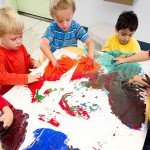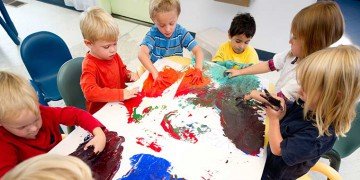Children tear holiday wrapping paper into small pieces of varying shapes, arrange them in patterns, and paste them on sheets of colored paper. When the collages are finished, their teacher asks the children questions, encouraging them to talk about their work. In Mary Jane Belt’s Long Island, New York, classroom, children sit at small tables, cutting out apple shapes, coloring them with crayons, and pasting them on the outline of a tree. Some of the children make holes in their apples and poke pieces of wiggly worm candy through the holes. In another classroom, a child stands at an easel carefully dipping a brush into small jars of paint and watching the colors blend together on the paper.
Art is an important part of your child’s early childhood education, regardless of whether you think he will grow up to be another Picasso. Children are active learners, and making art is a hands-on activity that expands imaginations and exercises creativity. It also develops small motor control and eye-hand coordination, and sharpens children’s powers of observation. The fundamentals of art: Children learn the fundamentals of art — color, line, shape, form and texture — by painting and drawing, making collages, fashioning three-dimensional objects out of clay, and talking about their work, says Alice W. Schwarz, associate museum educator at the Metropolitan Museum of Art in New York City. Three and four year olds recognize patterns, learn about primary colors, and discover how to mix two colors to make a third. Vocabularies expand to include words such as “texture,” “relief,” and “overlapping.” By creating art and looking at it, children gain an understanding of composition, balance, and symmetry.
The role of the artist
Art projects often begin with a discussion about a theme or color. The discussion is followed by set-up time, when the children put out the materials they need: scissors, paper, paint, crayons, etc. During the time they are working on the project, either individually or in small groups, they talk about their creations. After projects are completed, the children clean up, making sure everything is returned to its proper place.
Looking at art
The walls of preschool classrooms are often covered with works of art (the preschoolers’ own art together with reproductions from great masters), giving the room itself a creative energy.
Trips to museums sharpen children’s observational skills and require them to use their brains to put all the details together, says Schwarz. Children looking at Grant Wood’s painting The Midnight Ride of Paul Revere learn about an historic event, but they also figure out how to piece a story together from details of line, shape, and color.
Looking at illustrations in books gives preschoolers a sense of the way stories unfold and helps them learn to make predictions about what will happen next, says Bernice E. Cullinan, PhD, professor emerita at New York University and the author of Read to Me — Raising Kids Who Love to Read.
How art builds reading skills and more
Creating and looking at art has a positive influence on many different areas of your child’s intellectual, emotional and social development. She develops symbolic understanding by representing her experiences in paintings, drawings, collages, and models. This familiarity with symbols is key to beginning reading. Plus, when she talks about her artwork, your child is practicing communication skills and expanding her vocabulary- also critical for reading.
- Writing: Children often think of a story in pictures before they put it into words, says Cullinan. Drawing and painting helps preschoolers develop thoughts, and makes them want to write stories about their pictures. Learning to manipulate crayons and markers, and to use scissors helps children develop the coordination they need to write with pencils, says teacher Mary Jane Belt. It can also aid children in establishing hand dominance.
- Science: Children mix colors and watch the colors change, learning concepts of darker and lighter, says curriculum developer Barbara Sprung, co-director of Educational Equity Concepts. Drawing pictures of rain clouds gives children a sense of cause and effect. Making collages and modeling objects out of clay provides an understanding of the difference between two-dimensional and three-dimensional, says Schwarz.
- History: When children glue pretzel sticks together to make log cabins in recognition of Lincoln’s birthday, or design colonial villages at the sand table, they are learning about their history and about the way their ancestors lived, says Belt.
How to help at home
- Make art a part of your life. Have a variety of inexpensive art materials available: crayons, markers, safe scissors, paste, paper, old magazines and pieces of wrapping paper, play dough or reusable modeling clay.
- Involve your child in every step of the process, from set-up to clean-up.
- Allow your child the freedom of self-expression. Remember the process is more important than the product, says Schwarz. Don’t expect perfection.
- Ask your child questions and encourage her to talk about her work.
- Write your child’s name on his work and display it around the house where he can see it. Buy or make an inexpensive frame to show off his favorite picture.
- Have art in your home. Many museums sell inexpensive reproductions and posters from exhibits.
- Take your child to museums on a regular basis, but keep the trips short – no more than one hour.
- Make the trip a learning experience for you as well as your child. Let your child see you learning something new.
- Don’t lecture or overwhelm your child with facts about the history of impressionism. Encourage him to experience a painting for himself. Teach him to notice its details. Consider writing down his thoughts and discussing them later.
- If you feel uncomfortable in museums or talking about art, consider joining a parent/child class at your museum. Many of these classes are free.







